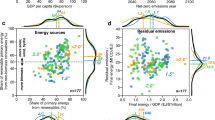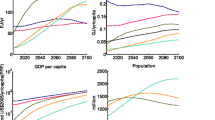Abstract
We present and apply a simple bottom–up model for estimating non-energy use of fossil fuels and resulting CO2 (carbon dioxide) emissions. We apply this model for the year 2000: (1) to the world as a whole, (2) to the aggregate of Annex I countries and non-Annex I countries, and (3) to the ten non-Annex I countries with the highest consumption of fossil fuels for non-energy purposes. We find that worldwide non-energy use is equivalent to 1,670 ± 120 Mt (megatonnes) CO2 and leads to 700 ± 90 Mt CO2 emissions. Around 75% of non-energy use emissions is related to industrial processes. The remainder is attributed to the emission source categories of solvent and other product use, agriculture, and waste. Annex I countries account for 51% (360 ± 50 Mt CO2) and non-Annex I countries for 49% (340 ± 70 Mt CO2) of worldwide non-energy use emissions. Among non-Annex I countries, China is by far the largest emitter of non-energy use emissions (122 ± 18 Mt CO2). Our research deepens the understanding of non-energy use and related CO2 emissions in countries for which detailed emission inventories do not yet exist. Despite existing model uncertainties, we recommend NEAT-SIMP to inventory experts for preparing correct and complete non-energy use emission estimates for any country in the world.
Similar content being viewed by others
References
Arbeitsgemeinschaft Energiebilanzen e.V.—AGE (2007) Vollständige Energiebilanzen 1990–2003. German working group on energy balances. AGE homepage
Central Bureau of Statistics—CBS (2006) Industrial production in the Netherlands. Confidential data for the period of 1990–2003. Voorburg, the Netherlands
Chemical Week (2000) Markets and economics—ammonia. ACCESS Intelligence Publication
Chemical Week (2006) Markets and economics—carbon black. ACCESS Intelligence Publication
Destatis—Statistisches Bundesamt (1990–2003a) Produzierendes Gewerbe. Fachserie 4, Reihe 3.1 Produktion im Produzierenden Gewerbe. Wiesbaden, Germany
Destatis—Statistisches Bundesamt (1990–2003b) Aussenhandel. Fachserie 7, Reihe 2 Aussenhandel nach Waren und Ländern (Spezialhandel). Wiesbaden, Germany
Food and Agriculture Organization of the United Nations—FAO (2006) Pesticides consumption. http://faostat.fao.org/site/424/default.aspx. Cited 5 January 2007
Freed R, Mintz C, Lanza R, Hockstadt L (2005) Analytic framework for analyzing non-energy uses of fossil fuels as petrochemical feedstock in the USA. Resour Conserv Recycl 45(3):275–294
Groenenberg H (2002) Development and convergence—a bottom-up analysis for the differentiation of future commitments under the climate convention. Dissertation, Utrecht University. Utrecht, The Netherlands
Institute for Prospective Technological Studies—IPTS (2001) Reference document on best available technologies in the non-ferrous metal industries. http://eippcb.jrc.es/pages/FActivities.htm. Cited 10 August 2004
Institute for Prospective Technological Studies—IPTS (2004) Reference document on best available technologies in the large volume inorganic chemicals, ammonia, acids, and fertilizers industries. Draft March 2004. Seville, Spain
Intergovernmental Panel on Climate Change—IPCC (1997) Greenhouse gas inventory reporting instruction, Revised 1996 IPCC guidelines for national greenhouse gas inventories (vol 1–3). IPCC WGI Technical Support Unit. Bracknell, United Kingdom
Intergovernmental Panel on Climate Change—IPCC (2006) 2006 IPCC guidelines for national greenhouse gas inventories. http://www.ipcc-nggip.iges.or.jp/. Cited 10 November 2006
Intergovernmental Panel on Climate Change—IPCC (2007) Working group III contribution to the Intergovernmental Panel on Climate Change forth assessment report. Geneva, Switzerland
International Energy Agency—IEA (2005a) Energy balances of OECD countries 1960–2003. CD-ROM, Paris, France
International Energy Agency—IEA (2005b) Energy balances of non-OECD countries 1971–2003. CD-ROM, Paris, France
International Energy Agency—IEA (2006) Annual questionnaires. http://www.iea.org/Textbase/stats/questionnaire/quest.asp. Cited 16 June 2008. Paris, France
International Energy Agency—IEA (2007) Tracking industrial energy efficiency and CO2 emissions—In support of the G8 plan of action. Paris, France
International Fertilizer Industry Association—IFA (2004) IFADATA-statistics, from 1973–1973/1974 to 2002–2002/2003. CD-ROM, Paris, France
Kuramochi T (2006) Differentiation of greenhouse gas emissions reduction commitments based on a bottom-up approach: focus on industrial efficiency benchmarking and future industrial activity indicators. Masters thesis, Utrecht University. Utrecht, The Netherlands
La Motta S, Santino D, Ancona P, Weiss M (2005) CO2 emission accounting for the non-energy use of fossil fuels in Italy: a comparison between NEAT model and the IPCC approaches. Resour Conserv Recycl 45(3):310–330
Marland G, Boden TA, Andres RJ (2006) Global, regional, and national CO2 emissions. In: Trends: a compendium of data on global change. Carbon Dioxide Information Analysis Center, Oak Ridge National Laboratory, U.S. Department of Energy, Oak Ridge, USA
Neelis ML (2006) De bruikbaarheid van de Nederlandse Prodcom-en energiestatistieken voor de berekening van CO2-emissies en energiebesparing in de chemische industrie. Centraal Bureau voor de Statistiek. Voorburg/Herlen, The Netherlands
Neelis ML, Patel MK, Blok K (2005a) CO2 emissions and carbon storage resulting from the non-energy use of fossil fuels in the Netherlands, NEAT results for 1993–1999. Resour Conserv Recycl 45(3):251–274
Neelis ML, Patel MK, Gielen DJ, Blok K (2005b) Modelling CO2 emissions from non-energy use with the non-energy use emission accounting tables (NEAT) model. Resour Conserv Recycl 45(3):226–250
Olivier JGJ (2005a) Part III: greenhouse gas emissions: 1. Shares and trends in greenhouse gas emissions; 2. Sources and methods—greenhouse gas emissions for 1990 and 1995. In: CO2 emissions from fuel combustion 1971–2003, 2005 edn. International Energy Agency (IEA), Paris, France. pp III-1–III-31
Olivier JGJ (2005b) EDGAR 32FT2000. Greenhouse gas emissions. http://www.mnp.nl/edgar/model/v32ft2000edgar/edgv32ft-ghg/edgv32ft-co2.jsp. Cited 3 July 2007
Olivier JGJ, Peters JAHW (2002) Uncertainties in global, regional and national emission inventories. In: Van Ham J, Baede APM, Guicherit R, Williams-Jacobse JFGM (eds) Non-CO2 greenhouse gases: scientific understanding, control options and policy aspects. Proceedings of the Third International Symposium, vol 21–23. Maastricht, The Netherlands, pp 525–540
Oil and Gas Journal (1999) Worldwide refining—OGJ special
Oil and Gas Journal (2001) Ethylene report
Park H (2005) Fossil fuel use and CO2 emissions in Korea: NEAT approach. Resour Conserv Recycl. 45(3):295–309
Patel MK (1999) Closing carbon cycles—Carbon use for materials in the context of resource efficiency and climate change. Dissertation, Utrecht University. Utrecht, The Netherlands
Patel MK, Jochem E, Marscheider-Weidemann F, Radgen P (1999) C-STRÖME: Abschätzung der Material-, Energie- und CO2-Ströme für Modellsysteme im Zusammenhang mit dem nichtenergetischen Verbrauch, orientiert am Lebensweg—Stand und Szenarienbetrachtung - Band I: Abschätzungen für das Gesamtsystem). Report prepared by Fraunhofer Institute for Systems and Innovation Research. Karlsruhe, Germany
Patel MK, Neelis ML, Gielen D et al (2005) Carbon dioxide emissions from non-energy use of fossil fuels: summary of key issues and conclusions from the country analyses. Resour Conserv Recycl. 45(3):195–209
Phylipsen D (2000) International comparisons & national commitments—Analysing energy and technology differences in the climate debate. Dissertation, Utrecht University. Utrecht, The Netherlands
Schmidt-Stejskal H, Steinlechner S, Windsperger A et al (2004) Studie zur Anpassung der Zeitreihe der Lösemittelemissionen der österreichischen Luftschadstoffinventur (OLI) 1980–2002. Report prepared for the Federal Environmental Agency of Austria. Vienna, Austria
Sonnenberg A, Sietz, M (2007) Pestizide in der Umwelt. FH Lippe und Höxter, Germany
Theloke J, Obermeier A, Friedrich R (2000) Ermittlung der Lösemittelemissionen 1994 in Deutschland und Methoden zur Fortschreibung. Universität Stuttgart, Insitut für Energiewirtschaft und Rationelle Energieanwendung (IER), Abteilung Technikfolgenabschätzung und Umwelt. Report No. 295 42 628 prepared for the Federal Environmental Agency of Germany. Berlin, Germany
Trischler (1997) Ermittlung von Altölvermeidungs-potenzialen. Trischler und Partner GmbH. Study issued by the German Environmental Agency (no 103 60 11 UBA-FB 97-034). Berlin, Germany
Ullmann F (1997) Encyclopedia of industrial chemistry, 5th edn on CD-ROM, vol A5. John Wiley and Sons Ltd.
Umweltbundesamt—UBA (2004) Workshop Nationales System Emissionsinventare. Themenpapier: Emissionen von Rest-und Sekundärrohstoffen. Umweltbundesamt. Federal Environmental Agency of Germany. 8–9 November 2004. Berlin, Germany
United Nations—UN (2000) Industry commodity production statistics database. 1950–2000
United Nations Framework Convention on Climate Change—UNFCCC (2005) Inventory review reports 2005. http://unfccc.int/national_reports/annex_i_ghg_inventories/inventory_review_reports/items/2767.php. Cited 10 July 2007
United Nations Framework Convention on Climate Change—UNFCCC (2006) National inventory submissions 2006, GHG inventories of Annex I countries. http://unfccc.int/national_reports/annex_i_ghg_inventories/national_inventories_submissions/items/3734.php. Cited 12 August 2006
Weiss M, Neelis ML, Blok K, Patel MK (2008a) Non-energy use and related carbon dioxide emissions in Germany: a carbon flow analysis with the NEAT model for the period of 1990–2003. Resour Conserv Recycl 52:1252–1262
Weiss M, Neelis ML, Zuidberg MC, Patel MK (2008b) Applying bottom-up analysis to identify the system boundaries of non-energy use data in international energy statistics. Energy 33:1609–1622
Weissermel K, Arpe HJ (2003) Industrial organic chemistry, 4th edn. Wiley-VCH
Worldbank (2004) World development indicators 2004. www.worldbank.org. Cited 12 August 2006
World Bureau of Metal Statistics—WBMS (2002) Metal statistics (1991–2002), 89th edn. Ware, England
Worrell E (1994) Potentials for improved use of industrial energy and materials. Dissertation, Utrecht University. Utrecht, The Netherlands
Author information
Authors and Affiliations
Corresponding author
Rights and permissions
About this article
Cite this article
Weiss, M., Neelis, M., Blok, K. et al. Non-energy use of fossil fuels and resulting carbon dioxide emissions: bottom–up estimates for the world as a whole and for major developing countries. Climatic Change 95, 369–394 (2009). https://doi.org/10.1007/s10584-009-9562-x
Received:
Accepted:
Published:
Issue Date:
DOI: https://doi.org/10.1007/s10584-009-9562-x




